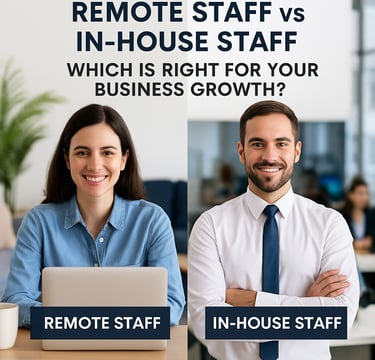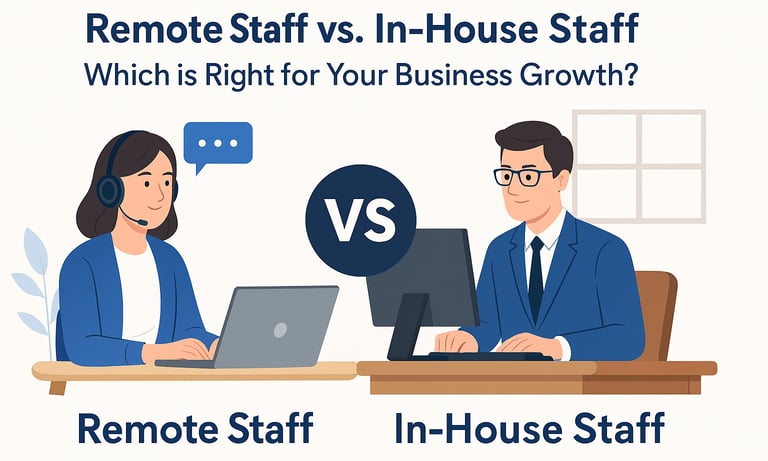Remote Staff vs In-House Staff: Which is Right for Your Business Growth?
When small and medium-sized enterprises (SMEs) start to scale, one of the most important decisions you’ll face is whether to hire in-house staff or build a remote team. Both approaches have their own benefits and challenges, and the decision you make can have significant effects on your productivity, costs, and long-term growth.
8/20/20252 min read


When small and medium-sized enterprises (SMEs) start to scale, one of the most important decisions you’ll face is whether to hire in-house staff or build a remote team. Both approaches have their own benefits and challenges, and the decision you make can have significant effects on your productivity, costs, and long-term growth.
💡 Want to skip the recruitment headaches? You can hire pre-vetted remote Virtual Assistants today through Wishup and start scaling your business in the next 24 hours.
Cost
In-House Staff: The costs of recruiting, onboarding, office space, and employee benefits can quickly add up. For SMEs with limited funds, these expenses can become overwhelming.
Remote Staff: Remote hires reduce overheads, eliminate the need for physical office space, and allow flexible payment structures. This is why many companies save up to 60% by outsourcing with remote Virtual Assistants.
👉 Make sure you are spending money wisely. Hire skilled remote staff using Wishup’s trusted platform.
Flexibility & Scalability
In-House Staff: Best suited for physical roles that require daily presence or ongoing collaboration. However, scaling an in-house team often takes time, approvals, and additional resources.
Remote Staff: Scaling is much easier. You can hire based on project demands or business growth. Remote teams give SMEs the ability to expand quickly without committing to long-term overhead costs.
Access to Global Talent
In-House Staff: Recruitment is limited to your local area, which means you may struggle to find niche or specialized skills.
Remote Staff: With remote hiring, you gain access to a global talent pool. Whether you need a bookkeeper, social media manager, or executive assistant, you’ll have far more options to find the perfect fit.
Productivity & Focus
In-House Staff: Having staff onsite can strengthen collaboration and company culture, but it can also lead to distractions such as commuting, long breaks, and office interruptions.
Remote Staff: Studies show remote workers are often more productive because they focus on measurable outputs, can prioritize work on flexible schedules, and experience fewer workplace distractions.
Confidentiality & Control
In-House Staff: Offers more direct control over daily activities and processes, but comes with risks such as office politics and higher turnover.
Remote Staff: Platforms like Wishup provide remote Virtual Assistants who are trained, vetted, and bound by confidentiality agreements, giving business owners extra peace of mind.
Which is Right for You?
The right choice depends on your business model:
If your work requires physical presence, then in-house staff is necessary.
If you want cost savings, flexibility, and global expertise, then remote staff is the intelligent option.
Conclusion
Overall, for fast-growing SMEs looking to keep costs down, remote staff provides the best opportunity. They offer access to global talent, scalability, and flexibility in today’s competitive business landscape.
👉 Ready to grow again? Hire your pre-vetted Virtual Assistant today from Wishup and start saving time and money—so you can focus on scaling your business.


Connect
Explore remote jobs and virtual assistant opportunities update
Support
leverage@lucasmedugu.com
+2348108547055
© 2025. All rights reserved.
Disclaimer
The content on Remote Growth Hub is for informational and educational purposes only. We do not provide financial, legal, or professional advice. Always do your own research before making business or financial decisions.
Some articles may contain affiliate links, meaning we may earn a commission if you make a purchase through them — at no extra cost to you. This helps support our blog and keep content free.
We strive for accuracy, but we make no guarantees regarding completeness, reliability, or results from using our content. By using this site, you agree that Remote Growth Hub is not responsible for any losses, damages, or decisions made based on the information provided.
